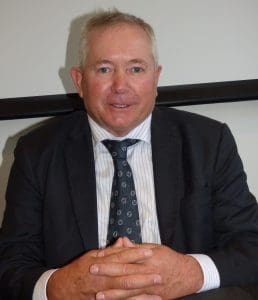
VFF Livestock Group president Leonard Vallance
VICTORIAN sheep and goat producers will know early next week how the electronic identification system for sheep and goats will be implemented and funded in the state.
In an invitation-only event on a Central Victorian farm next Monday, the government will outline the transition package for the plan to ensure all sheep and goats born in the state after January 1, 2017 are tagged with an electronic identification tag before being dispatched to a saleyard, abattoir or another property.
After July 1, 2017, all saleyards, abattoirs and knackeries will be required to scan electronic tags of sheep and goats and upload the information to the National Livestock Identification System (NLIS) database. Click here to get Sheep Central story links sent to your email inbox.
Despite wide state and national industry opposition to the Victorian Government’s decision, Victorian Farmers Federation Livestock Group president Leonard Vallance today said it would take five years for the sheep and goat EID system in Victoria to work, but the VFF had negotiated a “realistic” compliance rate for 2017.
“It will take five years to get the tags in all of the sheep and to get all of the equipment functioning and working properly.
“By the end of 2017, they’ve got to have 60 percent of the tags that were put in in 2017, read,” he said.
“That’s our figure, that’s what we wanted and that’s what we reckon is achievable.”
Mr Vallance said not many lambs will be born this season in the first half of 2017 and sold. The VFF did not want farmers to have to re-tag sheep with electronic tags.
“We’ve managed to keep everyone away from that.”
Mr Vallance said the VFF Livestock Group had managed to keep the cost of EID implementation down to sheep farmers and made it as simple as possible and with as much assistance as possible for the abattoirs and the saleyards.
“We were pushing pretty hard yesterday – we are still committed to the five year plan.”
But he said the biggest issue facing the government is knowing the number of lambs that would be born in the state next year.
“Tell me how many lambs are going to be marked in Victoria and see how far the money is going to go?
“If there is a 30pc increase in the number of lambs dropped that blows the budget, doesn’t it?” he said.
However, Mr Vallance was confident the government had a plan to ensure the VFF’s requirement for ‘cost neutral’ tags to be available to producers would be met, despite subsidised electronic tags from Agriculture Victoria’s online service selling for 77-150 cents.
“They average the price in all their budgets and they’ve subsidised the price down to the average price; that’s how they’ve worked it.
“At the moment there are estimates that there will between 6-12 million lambs marked in Victoria next year – that’s a big spread – but they’ve gone to the other end where it (the budget) can’t be broken; they’ve gone very conservative on that,” he said.
“There are six million lambs that may or may not be tagged.”
Mr Vallance said the government had told him it was not known how many sheep tags were sold in Victoria last year because they were sold through various outlets and “no-one really knows where they went.”
“No-one knows what the lamb drop was this year.”
Funding to come from port lease
Mr Vallance believed the funding for the transition package would come from the lease of the Port of Melbourne, including enough money to update saleyard infrastructure. He did not see any need to delay the EID implementation or hold a trial in a saleyard as proposed by saleyard operators, agents and national producer groups.
“Most of the farmers I have talked to are pretty relaxed about.
“It’s the saleyard operators who have got to get things organised,” he said,
“But the flipside of that is, is that this is a great opportunity for saleyard operators to get to get capital input into saleyards and improve them.
“Get the drainage right, get the truck flows right, put them undercover and modernise things so that they are ready to go,” Mr Vallance said.
“The government is committed to this, so they have got to assist with infrastructure and planning.
“They’ve got to take the positive line and say well here is an opportunity, rather than a distraction, let’s get on and make this thing work for us.”
Mr Vallance said the main reason to bring in EID for sheep and goats in Victoria was bring into line with the EID-tag based National Livestock Identification System for cattle.
“The sheep industry is just catching up with the cattle industry.”
Mr Vallance said criticism of the Victorian decision as inconsistent with the current NLIS system was undermined by Western Australia’s state requirement for transaction tags.
“There is not nationally consistent system now, it’s all over the place; it’s a dog’s breakfast.
“In two years’ everybody will say ‘what was all the fuss about’?”



HAVE YOUR SAY